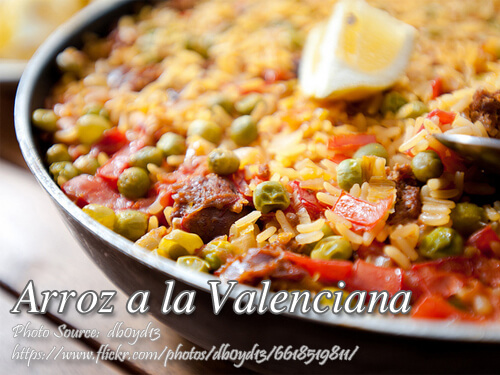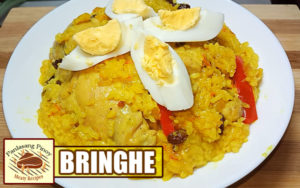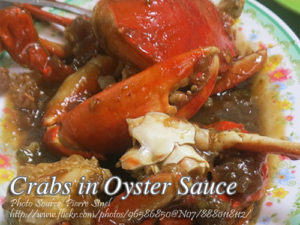Arroz Valenciana is a rice based dish using glutinous rice, chicken, pork, coconut milk, vegetables and spices. It is similar to paella but instead of including various seafood like mussels, prawns, squid, clams and crabs in the dish, arroz valenciana uses pork and chicken only or some chorizos. This dish is actually a Latin American dish that is also part of the Filipino cuisine.
Arroz Valenciana: A Hearty Celebration on a Plate
In our family, no grand celebration feels complete without a hearty serving of arroz valenciana gracing the dining table. This vibrant dish is the ultimate centerpiece, bringing together tender meat, creamy coconut milk, and the sticky delight of glutinous rice in one colorful medley. Every spoonful seems to carry stories of togetherness, laughter, and the comforting taste of home.
I first fell in love with it as a child, watching my Tita Fe expertly prepare it during family reunions. She would say that this dish is more than food—it’s a symbol of the joy and abundance we Filipinos love to share. True enough, every bite felt like a warm embrace, and the flavors seemed to carry the unmistakable magic of family traditions.
What Makes Arroz Valenciana Unique
Arroz valenciana, often referred to as the Filipino version of paella, is a dish that embodies our rich cultural heritage. Though it shares similarities with the Spanish classic, its use of coconut milk, glutinous rice, and pork or chicken gives it a distinctively Filipino touch. Unlike paella, which often features seafood like mussels or prawns, this dish focuses on simpler yet equally flavorful ingredients, making it more accessible to the everyday cook.
Interestingly, it has its roots in Latin America, introduced to the Philippines during the colonial period. Over time, Filipino cooks infused their own flair, adding ingredients like atsuete seeds for a deep, golden hue and coconut milk for a creamy texture. This evolution has made the rice dish a staple for fiestas, birthdays, and Noche Buena.
Cooking the Perfect Arroz Valenciana
When my Kuya Mark got married, I decided to try my hand at making it for the reception dinner. I still remember the mix of excitement and nerves as I worked through Tita Fe’s handwritten recipe. One thing I learned that day is that this dish, while simple, requires a balance of patience and care to perfect.
The process begins with boiling a mixture of glutinous rice and regular rice in coconut milk and a pinch of salt. This combination ensures a rich, slightly sticky base that’s both hearty and comforting. The coconut milk doesn’t just add flavor; it also lends a creamy texture that binds the dish together beautifully.
Meanwhile, the chicken and pork pieces are fried until golden and set aside. Using the same oil, atsuete seeds are rendered to release their vibrant color. This step is key to achieving the signature golden-orange hue that makes arroz valenciana so visually appealing. Once the seeds are removed, garlic, onions, and tomato sauce are sautéed in the flavored oil, creating a savory base that complements the richness of the rice.
The fried meats are then returned to the pan, simmering gently in the sauce until tender. This technique ensures the flavors seep into every bite of meat, enhancing its taste and texture. Finally, the rice mixture is added back in, along with vegetables and chorizos, blending into a harmonious dish that’s as delicious as it is aromatic.
A Dish That Brings People Together
When my cousin Carla came home from studying abroad, one of her first requests was for our family’s arroz valenciana. She said that no dish reminded her more of home than this one. True enough, as we sat down to share it, the air was filled with stories, laughter, and the comforting aroma of coconut milk and atsuete.
For many Filipino families, it isn’t just food—it’s a tradition. It’s the dish we turn to when we want to celebrate milestones, mark holidays, or simply come together as one. The garnish of hard-boiled eggs and parsley strips may seem like a small touch, but they add a festive vibe that makes the dish perfect for special occasions.
Food for Thought: A Glimpse Into Its History
While Arroz Valenciana is beloved in Filipino households, its origins are a testament to our shared history with Latin America and Spain. Variations of this dish, known as Arroz a la Valenciana, are popular in countries like Nicaragua and Venezuela, where it’s also associated with celebrations. The Filipino version’s use of coconut milk and glutinous rice highlights how we’ve adapted global influences to suit our local palate and ingredients.
This dish is also a reminder of the resilience and creativity of Filipino cooks. Despite using humble ingredients, they’ve managed to create something truly special, rich in flavor and meaning. It’s no wonder it has become a household favorite for generations.
Why You Should Try This Recipe
Whether you’re cooking for a crowd or simply want to try something new, it is the perfect dish to showcase your culinary skills. Its blend of creamy, savory, and subtly sweet flavors will undoubtedly impress your guests. Plus, the cooking techniques involved—from rendering atsuete for color to simmering meats until tender—are not only practical but also a great way to deepen your appreciation for Filipino cuisine.
So, the next time you’re planning a celebration or craving a taste of home, give it a try. Who knows? It might just become a staple in your household, as it has in ours. And as you enjoy each spoonful, may it bring you the same warmth and joy it has brought to my family over the years.
How to Cook Arroz Valenciana
Ingredients
- 1 & 1/2 cup glutinous rice malagkit
- 1 & 1/2 cup white rice
- 1 & 1/2 tsp. salt
- 5 cup coconut milk
- 1/2 cup cooking oil
- 1 young chicken cut into serving pieces
- 1/4 kg. pork cut into serving pieces
- 2 Tbsp. garlic crushed
- 1 large onion sliced
- 1 8 oz can tomato sauce
- 1 Tbsp. salt
- 1/4 tsp. white pepper
- 1/4 tsp. paprika
- 2 Tbsp. atchuete seeds or annato seeds
- 6 pcs potatoes quartered and fried
- 1 small can sweet peas
- 1 pc red-sweet pepper sliced
- 2 pcs hard-boiled eggs sliced
- parsley
Instructions
How to Cook Arroz Valenciana
- Boil the malagkit-rice mixture, salt, and coconut milk in a saucepan. Stir once in a while to prevent burning.
- Fry the chicken-pork pieces in hot oil; set aside.
- In the same fat, render off color from atchuete seeds; discard seeds.
- Saute garlic, onion, and add tomato sauce. Season with salt and pepper.
- Add the fried meat and simmer until tender.
- Add the rice mixture; blend well. Add the rest of the ingredients and combine lightly.
- Arrange on a platter and garnish with hard-boiled eggs and strips of parsley.
- Good for 12 persons.
Notes
Cooking Tips:
Use the Right Rice Combination for Perfect Texture
A mix of glutinous rice and regular rice is key to achieving the perfect balance of stickiness and fluffiness. The glutinous rice gives the dish its signature creamy texture, while the regular rice prevents it from becoming too dense. Make sure to rinse the rice thoroughly to remove excess starch and ensure even cooking.Don't Skip the Atsuete Oil for Vibrant Color
Rendering atsuete seeds in oil is an essential step to achieve the rich, golden-orange hue that makes it visually appealing. The oil also enhances the dish's overall flavor, adding a subtle earthiness that complements the coconut milk. Be patient during this step to fully extract the natural pigments and then strain the seeds to avoid a gritty texture.Simmer the Meat for Tender, Flavorful Bites
After frying the chicken and pork, simmer them in the tomato-based sauce to allow the flavors to meld and the meat to become tender. This process not only infuses the meat with savory goodness but also enriches the sauce itself. Use a low heat setting to prevent overcooking, ensuring every bite of meat is juicy and flavorful.






Hi Mags, if the rice is raw, you can correct it by adding more water. Just do it gradually to prevent it from turning into a paste. The recipe also says to stir it once in a while to prevent the rice from burning.
me tanong lang po ako, d ako Madunong mag luto ng bigas sa ibabaw ng stove…kundi hilaw,malambot (parang lugaw) or sunog. ….sa arroz valenciana panno ko macocorrect pag na hilaw yun bigas.
All r yummy,love it,,